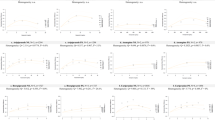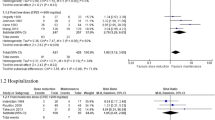Abstract
Background
Perospirone is a second-generation antipsychotic (SGA) used only in Japan, and acts as a serotonin (5-HT)1A receptor partial agonist, 5-HT2A receptor inverse agonist, and dopamine (D)2, D4, and α1-adrenergic receptor antagonist. To our knowledge, no meta-analysis addressing the efficacy and effectiveness of perospirone in schizophrenia has been published to date.
Objective
The aim of the study was to identify the characteristics of perospirone by assessing the efficacy, discontinuation rate, and side effects of perospirone versus other antipsychotics in the treatment of patients with schizophrenia.
Methods
Using information obtained from the PubMed, PsycINFO, Google Scholar and Cochrane Library databases without language restrictions published up to 10 June 2013, we conducted a systematic review and meta-analysis of patient data from randomized controlled trials comparing perospirone with other antipsychotic medications. Risk ratio (RR), standardized mean difference (SMD) and 95 % confidence intervals were calculated. All studies used the Positive and Negative Syndrome Scale (PANSS) for the evaluation of the schizophrenia psychopathology.
Results
The search in PubMed, Cochrane Library databases, Google Scholar and PsycINFO yielded 69 hits. We included three studies in the current meta-analysis and excluded 66 studies based on title, abstract, and full text review. Moreover, two additional studies were identified from a review article. Across the five studies (mean duration 9.6 weeks), 562 adult patients with schizophrenia were randomized to perospirone (n = 256), olanzapine (n = 20), quetiapine (n = 28), risperidone (n = 53), aripiprazole (n = 49), haloperidol (n = 75), or mosapramine (n = 81). Perospirone was not different from other pooled antipsychotics regarding reduction in PANSS negative (SMD = 0.38, p = 0.09) and general (SMD = 0.28, p = 0.06) subscale scores, and discontinuation due to any cause (RR = 1.03, p = 0.83), inefficacy (RR = 0.99, p = 0.98) and side effects (RR = 0.72, p = 0.25). However, perospirone was inferior to other pooled antipsychotics in the reduction of PANSS total scores (SMD = 0.36, p = 0.04) and positive subscale scores (SMD = 0.34, p = 0.03). Moreover, excluding the comparison of perospirone with the first-generation antipsychotic (haloperidol), perospirone was inferior to other pooled SGAs in the reduction of PANSS total scores (SMD = 0.46, p = 0.02), positive (SMD = 0.42, p = 0.03), negative (SMD = 0.52, p = 0.02) and general subscale scores (SMD = 0.37, p = 0.03). However, perospirone was superior to haloperidol in the reduction of PANSS negative subscale scores (SMD = −0.41, p = 0.01). Perospirone also had lower scores related to extrapyramidal symptoms than other pooled antipsychotics (SMD = −0.30, p = 0.01).
Conclusions
Our results suggest that although perospirone seems to be a well tolerated treatment, perospirone does not reduce PANSS score as much as other SGAs.









Similar content being viewed by others
References
Onrust S, McClellan K. Perospirone. CNS Drugs. 2001;15(4):329–37.
Miyamoto S, Duncan GE, Marx CE, Lieberman JA. Treatments for schizophrenia: a critical review of pharmacology and mechanisms of action of antipsychotic drugs. Mol Psychiatry. 2005;10(1):79–104.
Kishi T, Matsuda Y, Nakamura H, Iwata N. Blonanserin for schizophrenia: systematic review and meta-analysis of double-blind, randomized, controlled trials. J Psychiatr Res. 2013;47:149–54.
Takekita Y, Kato M, Wakeno M, Sakai S, Suwa A, Nishida K, et al. A 12-week randomized, open-label study of perospirone versus aripiprazole in the treatment of Japanese schizophrenia patients. Prog Neuropsychopharmacol Biol Psychiatry. 2013;40:110–4.
Kudo Y, Nakajima T, Saito M, Sakai T, Otsuki S, Yamasaki S, et al. Clinical evaluation of a serotonin-2 and dopamine-2 receptor antagonist (SDA), perospirone HCI on schizophrenia: a comparative double-blind study with mosapramine HCI. Clin Eval. 1997;24:207–48.
Murasaki M, Koyama T, Yukiteru M, Gohei Y, Kamijima K, Toru M, et al. Clinical evaluation of a new antipsychotic, perospirone HCI, on schizophrenia: a comparative double-blind study with haloperidol. Clin Eval. 1997;24:159–205.
Yamashita H, Mori K, Nagao M, Okamoto Y, Morinobu S, Yamawaki S. Effects of changing from typical to atypical antipsychotic drugs on subjective sleep quality in patients with schizophrenia in a Japanese population. J Clin Psychiatry. 2004;65:1525–30.
Okugawa G, Kato M, Wakeno M, Koh J, Morikawa M, Matsumoto N, et al. Randomized clinical comparison of perospirone and risperidone in patients with schizophrenia: Kansai Psychiatric Multicenter Study. Psychiatry Clin Neurosci. 2009;63:322–8.
Kay SR, Fiszbein A, Opler LA. The positive and negative syndrome scale (PANSS) for schizophrenia. Schizophr Bull. 1987;13(2):261–76.
Cohn LD, Becker BJ. How meta-analysis increases statistical power. Psychol Methods. 2003;8(3):243–53.
Stroup DF, Berlin JA, Morton SC, Olkin I, Williamson GD, Rennie D, et al. Meta-analysis of observational studies in epidemiology: a proposal for reporting. Meta-analysis Of Observational Studies in Epidemiology (MOOSE) group. JAMA. 2000;283(15):2008–12.
Inada T, Yagi G, Miura S. Extrapyramidal symptom profiles in Japanese patients with schizophrenia treated with olanzapine or haloperidol. Schizophr Res. 2002;57(2–3):227–38.
Inada T, Yagi G. Current topics in neuroleptic-induced extrapyramidal symptoms in Japan. Keio J Med. 1996;45(2):95–9.
DerSimonian R, Laird N. Meta-analysis in clinical trials. Control Clin Trials. 1986;7(3):177–88.
Higgins JP, Thompson SG, Deeks JJ, Altman DG. Measuring inconsistency in meta-analyses. BMJ. 2003;327(7414):557–60.
Leucht S, Corves C, Arbter D, Engel RR, Li C, Davis JM. Second-generation versus first-generation antipsychotic drugs for schizophrenia: a meta-analysis. Lancet. 2009;373(9657):31–41.
Leucht S, Komossa K, Rummel-Kluge C, Corves C, Hunger H, Schmid F, et al. A meta-analysis of head-to-head comparisons of second-generation antipsychotics in the treatment of schizophrenia. Am J Psychiatry. 2009;166(2):152–63.
Rummel-Kluge C, Komossa K, Schwarz S, Hunger H, Schmid F, Kissling W, et al. Second-generation antipsychotic drugs and extrapyramidal side effects: a systematic review and meta-analysis of head-to-head comparisons. Schizophr Bull. 2012;38(1):167–77.
Inagaki A, Inada T. Equivalent doses of psychotropic drugs. Jpn J Clin Psychopharmacol. 2006;9(7):1443–7.
Correll CU, Manu P, Olshanskiy V, Napolitano B, Kane JM, Malhotra AK. Cardiometabolic risk of second-generation antipsychotic medications during first-time use in children and adolescents. JAMA. 2009;302(16):1765–73.
Acknowledgments
We thank Dr Hidehisa Yamashita (Department of Psychiatry and Neurosciences, Graduate School of Biomedical Sciences, Hiroshima University) for providing data (PANSS positive, negative, and general subscale scores) from the study by Yamashita et al. [7]. We also thank Mr Hiroshi Nakamura for contribution to a part of the literature search.
Conflicts of interest and source of funding
Drs Kishi and Iwata declare that they have no direct conflicts of interest relevant to this study. No grant support or other sources of funding were used to conduct this study or prepare this article. Dr Kishi has received speaker’s honoraria from Abbott, Astellas, Daiichi Sankyo, Dainippon Sumitomo, Eli Lilly, GlaxoSmithKline, Yoshitomi, Otsuka, Meiji, Shionogi, Tanabe-Mitsubishi, Novartis and Pfizer.
Dr Iwata has received speaker’s honoraria from Astellas, Dainippon Sumitomo, Eli Lilly, GlaxoSmithKline, Janssen, Yoshitomi, Otsuka, Meiji, Shionogi, Novartis and Pfizer.
Contributors
Dr Kishi had full access to all of the data in the study and takes responsibility for the integrity of the data and the accuracy of the data analysis. Dr Kishi was responsible for the study concept and design, analysis and interpretation of data, and statistical analysis. Acquisition of data, and drafting of the manuscript were undertaken jointly by Drs Kishi and Iwata. Dr Iwata was responsible for study supervision.
Author information
Authors and Affiliations
Corresponding author
Rights and permissions
About this article
Cite this article
Kishi, T., Iwata, N. Efficacy and Tolerability of Perospirone in Schizophrenia: A Systematic Review and Meta-Analysis of Randomized Controlled Trials. CNS Drugs 27, 731–741 (2013). https://doi.org/10.1007/s40263-013-0085-7
Published:
Issue Date:
DOI: https://doi.org/10.1007/s40263-013-0085-7




